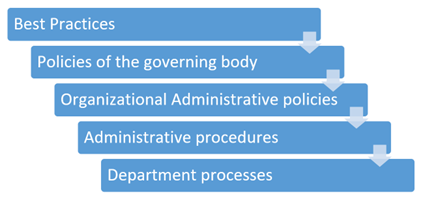Why Policies MatterGovernment agencies are subject to a variety of rules and regulations stemming from state law, local charter or code, and ordinances or resolutions adopted by the governing body. Financial policies provide
a framework within which to ensure effective financial management and to provide continuity between administrations. As staff turnover occurs or elected officials change, the policy framework provides consistency and a roadmap to effective financial
management. What if a new governing body wishes to spend into budget reserves? A well-constructed budget reserves policy will make this more challenging without public discussion. What if a new chief executive wishes to cut corners during procurements?
A comprehensive procurement policy will prevent this from occurring without deliberate action of the governing body.
Without a robust and current policy framework in place, there is an increased risk of critical tasks being overlooked,
compliance failures with grant programs, state laws, or local charter or ordinance requirements, and/or misalignment of financial operations with the overall mission of the organization. When things go wrong, the shortcomings of policy can become
clear. The likelihood of this occurring is greatly diminished with proper attention to policy
Policy Framework and HierarchyA comprehensive policy library should be stratified into policies that are appropriate
for approval by the governing body, policies of an administrative nature that are best updated without involving the governing body, and procedures outlining the execution of these policies rather than the content. The governing body should be
asked to weigh in on the critical items that either merit their direction (e.g., when do they want to approve purchases or amendments to the budget) or for which staff would be uncomfortable making a decision (e.g., when to waive competitive bidding
or when to write off a large receivable). The graphic below illustrates this hierarchy:

A
good example is of policies and procedures governing fixed assets. The governing body may want to weigh in on the process for disposing of surplus assets or the appropriate replacement schedule for certain classes of assets. An administrative
policy expanding on this direction might discuss specific dollar amounts that are appropriate for capitalization, further guidelines for determining assets appropriate for disposal, and approval guidelines for asset replacement. A related administrative
procedure might discuss the actual processes for asset inventories and asset disposals, with appropriate forms or software instructions attached.
The important thing to remember is that consistency matters. Determine what content
is appropriate for each level in the hierarchy and strive for consistency across the different categories of policies and procedures to the extent practicable.
Developing or Expanding a Policy LibraryWhether
you are starting a new policy library or reviewing your existing one to make sure that it is comprehensive, there are a few key steps to take during this process. First, ensure that the necessary categories of policy are included. Examples of
these include budget administration, procurement, accounting operations, risk management, debt administration, investments, and other appropriate areas. The Government Finance Officers Association (GFOA) provides some helpful guidance in this
area. Peer jurisdictions and relevant consultants, such as your municipal advisor or investment advisor can also provide sample policies as a starting point. There is no need to reinvent the wheel in your efforts but remember that every agency
is different and so too should be the nuances of their policy choices.
Once you know what lies ahead to complete your policy library, take measured steps to see it through to completion. Do not bite off too much initially – start
with the critical policies and then fill in the gaps as time allows until you are satisfied with the content of your library. If your department staffing permits, consider delegating policy categories to staff for assistance that can then help
with future updates.
Keeping Your Library CurrentIt is not enough to just have a solid policy library in place; you have to monitor and update it regularly. External requirements, policy goals of the governing
body, and internal processes and practices change over time. Rather than trying to remember which policies and procedures are impacted by these changes, a regular schedule for updates can be helpful to initiate detailed review and identify any
required revisions. This can be part of an overall strategy for cataloging and tracking policy updates.